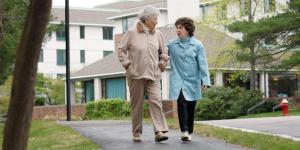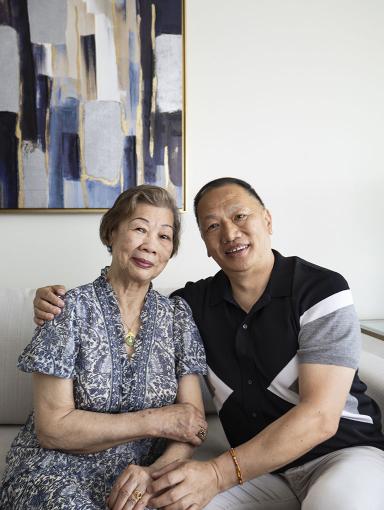Benefits of Meditation for Seniors
Meditation can support healthy aging. Understanding what meditation is, how it can help you, knowing how to get started, and maintaining a consistent practice are key.

The earliest depiction of people in meditation appears on cave walls painted between 3,500 – 5,000 years ago in the Indus Valley. Throughout history, most major world religions have included some form of meditation in their spiritual practices and today various forms of meditation have become a common component of western wellness recommendations.
What Is Meditation?
Many of us associate meditation with mindfulness meditation, which is a secularized method stemming from ancient Buddhist contemplative practice.
Jon Kabat-Zinn, Ph.D., is often credited with popularizing mindfulness meditation. He developed the Mindfulness-Based Stress Reduction program at the University of Massachusetts Medical School and defines mindfulness meditation as “the awareness that arises from paying attention, on purpose, in the present moment and non-judgmentally.”
Types of Meditation
There are many meditation methods that help practitioners work with their minds, with or without specific spiritual or therapeutic goals.
- Body-centered meditation involves mentally scanning your body to see where you may be holding tension and then letting go of any “knots,” physical or emotional.
- Contemplation is a practice that uses a question, concept, or problem as a point of concentration to help cultivate your capacity to stay focused in the midst of distraction.
- Emotion-centered meditation is designed to help you work with feelings and emotions and to cultivate kindness and compassion toward others as a path to a happier and more fulfilling life. It helps you see disturbing thoughts that lead to anger or depression and investigate their source rather than try to rid yourself of them.
- Mantra meditation involves repeating words or sounds either silently or out loud to calm discursive thoughts.
- Meditation with movement involves working with your body to focus and calm the mind. Yoga and tai-chi are often used, but the movement can be as simple as walking, noticing your contact with the ground and what you see, hear, smell, and feel through your senses.
The idea with all these techniques is to bring attention to the body and mind as it is moment to moment. The theory is that meditation then helps you cope with pain, both physical and emotional, by cultivating a sense of calm and resilience in the face of life’s challenges.
But is this claim backed up by science?
The Evolution of Meditation Research
Meditation research began in the 1950s with psychological studies followed by clinical research in the 1970s. Strides in understanding the physiological effects of meditation have been made in recent years through the convergence of meditation research with neuroscience, which deals with the structure and function of the nervous system and the brain.
Brain Versus Mind: What’s the Difference?
A simple way to understand the distinction between mind and brain is to define the mind as our ability to think, feel, and engage in physical activity. The brain, on the other hand, refers to the physical organ in our head that supports these functions. According to experts who review and evaluate meditation research, there is much more to discover about the impact of meditation on the brain and the impact of the brain on meditation.
Preliminary studies have indicated that meditation may impact brain plasticity (or neuroplasticity), which involves the process of structural changes the brain makes to maintain or optimize function. Science has thankfully disproved earlier assumptions that plasticity is lost with age. We now know that the brain can adapt throughout the life span.
That meditation may support brain plasticity has implications for many of the challenges we face with age, including:
- Maintaining cognitive health
- Mitigating pain
- Coping with depression and grief
- Reducing anxiety
Meditation and Cognitive Reserve
Alvaro Pascual-Leone, M.D., Ph.D., is the medical director of the Deanna and Sidney Wolk Center for Memory Health at Hebrew SeniorLife and a professor of neurology at Harvard Medical School. A major focus of Dr. Pascual-Leone’s research is on maintenance of brain health across the lifespan. As part of that research, he has helped define and is examining cognitive reserve, which is a factor that helps explain why some individuals age more successfully than others. Those with greater cognitive reserve are better able to cope with pathological onslaughts to the brain.
Using a tool developed by Brad Manor, Ph.D., from the Hinda and Arthur Marcus Institute for Aging Research at Hebrew SeniorLife, Dr. Pascual-Leone has measured the cognitive reserve of older individuals before and after teaching them to meditate. Subjects showed marked improvement in cognitive reserve after implementing meditation as the only intervention
A Word of Caution
Studies that have looked at meditation as a treatment for serious pain, depression, and withdrawal from nicotine, alcohol, or opioid addiction have been preliminary, and are not considered to be conclusive by many in the research community. Meditation takes many forms and practitioners vary widely in terms of experience, making it difficult to design rigorous studies that meet scientific standards for methods and analysis.
Meditation should never be used as a substitute for medical treatment of serious and life-threatening diseases and is generally used as a complementary method for managing illness.
While the jury is still out on meditation as a measurable treatment for physiological illness, there is still plenty to gain by learning techniques that help you relax, cope with emotions like sadness and grief, and teach you how to become friends with yourself and your life.
Advice from a Life-Long Meditator
Sheila Wolfson, a resident at Hebrew SeniorLife’s Orchard Cove community in Canton, MA, teaches a weekly meditation class. She started meditating in 1972, using a method called Transcendental Meditation®, and later learned mindfulness meditation.
“To live life at its fullest is a great benefit of meditation,” says Sheila. “I think meditation is a wonderful fit for people who are older.”
How to Meditate
Here is a simple guide on how you can get started with mindfulness meditation.
- Sit comfortably in an upright position. Find a spot that gives you a stable, solid, comfortable seat. Visualize your spine as a column of golden coins stacked one on top of the other. Hold yourself as erect as possible, but don’t stiffen. Your spine has natural curvature–let it be there. As a saying goes to describe correct meditation posture, “not too tight, not too loose.”
- Soften your gaze. Tuck your chin in a little and let your gaze fall gently downward. It’s not necessary but OK to close your eyes.
- Focus on your breath. Bring your attention to the physical sensation of breathing: the temperature of the air moving through your nose or mouth, the rising and falling of your abdomen or chest.
- Notice when your mind wanders. Inevitably, your attention will leave the breath and wander to other places. That’s fine–it’s impossible to eliminate thoughts. You can label them “thinking,” and return to the breath. Instead of wrestling with your thoughts, practice observing them without reacting. Just sit and pay attention.
- When you’re ready, gently lift your gaze (if your eyes are closed, open them). Take a moment and notice any sounds in the environment. Notice how your body feels right now. Notice your thoughts and emotions.
It’s often said that mindfulness meditation is simple but not easy, so ease into it. If you find that you can only sit for five minutes to start, that’s fine. As you become familiar with the technique, you’ll be able to sit for longer periods of time.
“Consistency is important to reaping the benefits of meditation,” says Sheila. She recommends people meditate at the same time in the same place to develop it as a healthy habit.
With practice, you too can experience the calm and sense of well-being that can come with meditation. You may just find that those folks in the Indus Valley 5,000 years ago were on to something.
Blog Topics
Learn More
A Community for Residents, By Residents
Orchard Cove, in Canton, MA, offers living options that span the full continuum of care, including independent living. The community is bustling with activities, from life-long learning to entertainment.

Programming for Every Interest
At Orchard Cove in Canton, MA, you can discover your hidden talents. Whether it's art, discussing current events, writing, cooking, kayaking, or gardening, there are many programs to explore.




